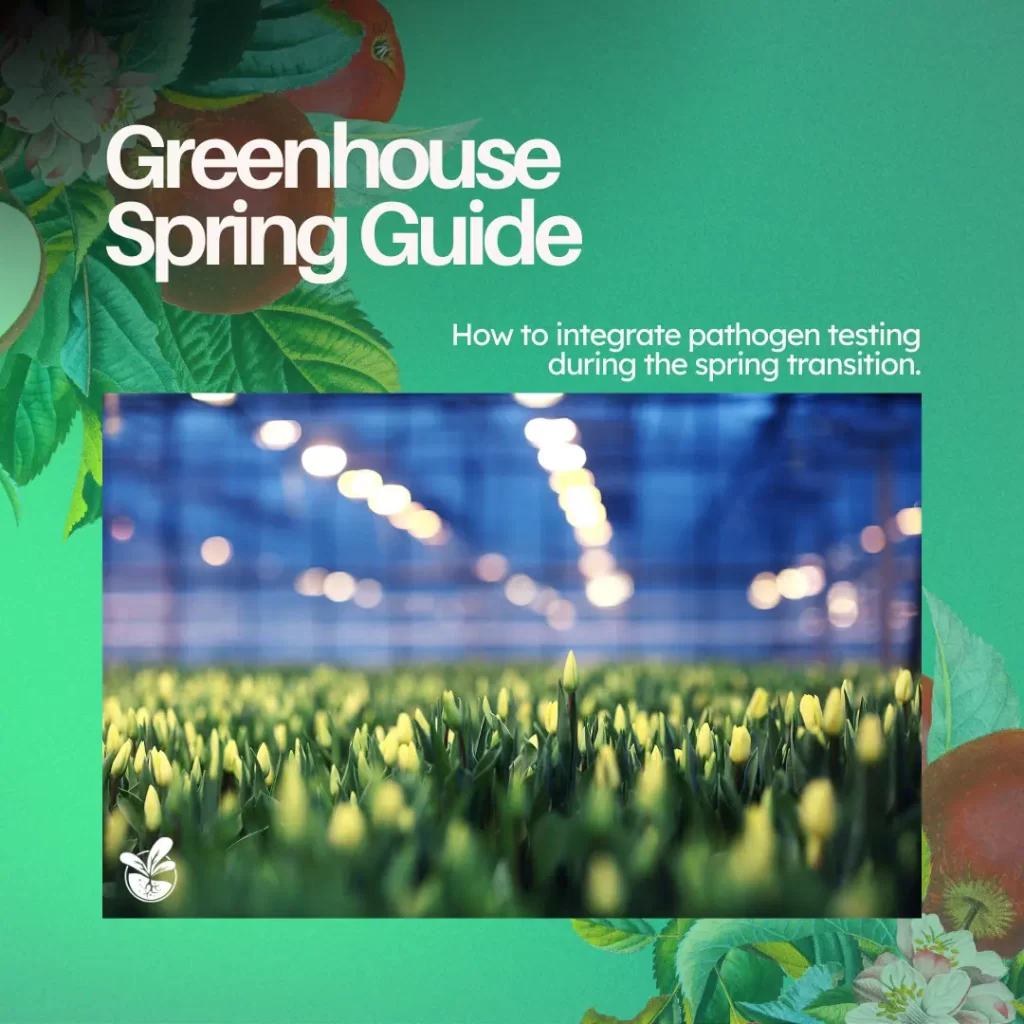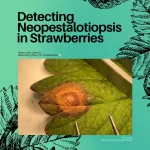Spring Conditions and Greenhouse Pathogens (Spring Greenhouse Guide)
Spring greenhouse disease prevention is crucial for a successful growing season, especially as the days become sunnier. By mid-April, many Canadian greenhouse operations—especially in southern Ontario, British Columbia, and Quebec—have already cycled through winter propagation and are in full spring production of tomatoes, peppers, cucumbers, strawberries, and ornamentals, relying on supplemental lighting and climate control to sustain 21–27 °C days and 16–18 °C nights.
Spring transplant rotations for warm-season crops typically begin in March for leafy greens, April for tomatoes, and May for peppers, ensuring a continuous supply despite variable outdoor temperatures. However, moderate spring temperatures (15–25 °C), high humidity (> 85 % RH), and dense canopy cover create an ideal breeding ground for pathogens such as Leveillula taurica, Botrytis cinerea, Phytophthora infestans, and Fusarium oxysporum. This convergence makes precise environmental control and proactive disease surveillance within an IPM framework essential.
Let’s take a look at different growing operations and what things to expect and do during spring.
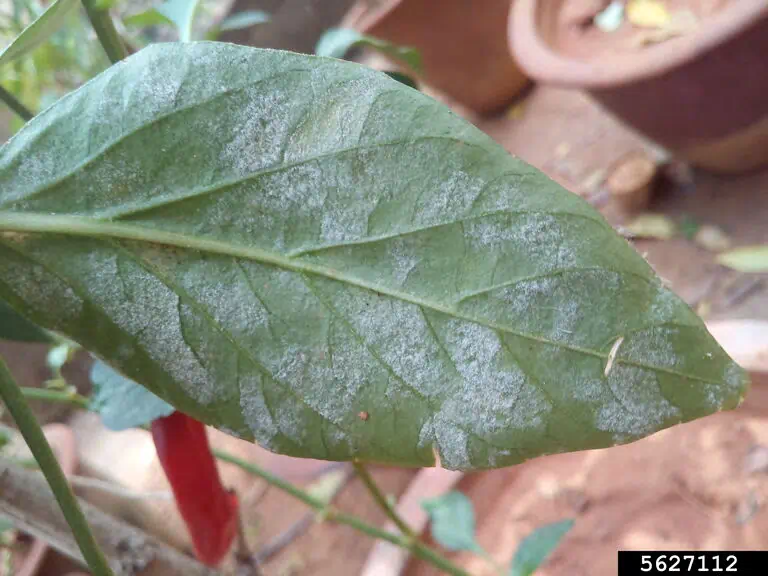
Spring Greenhouse Disease Prevention in Bell Peppers: Powdery Mildew & Fusarium
Spring Pathogen Snapshot
In April, Leveillula taurica powdery mildew exploits cooler nights (5–10 °C) and daytime highs of 20–25 °C, producing zoospores that establish infections deep within the abaxial leaf tissue during an 18–21 day endophytic phase before visible sporulation occurs. Greenhouse “pockets” where relative humidity (RH) exceeds 85%—often in poorly ventilated corners or under dense canopies—accelerate the development of conidiophores and spore release.
Currently, aggressive strains of Fusarium oxysporum detected in spring Ontario surveys at an incidence of up to 30% (https://pubmed.ncbi.nlm.nih.gov/30823089/), germinate from chlamydospores in contaminated media and infect stems and fruits as soon as soil temperatures surpass 15 °C.
Challenges to Spring Greenhouse Disease Prevention
- Leveillula taurica remains endophytic for up to 18–21 days before producing visible conidiophores, allowing infections to spread undetected across benches and fl owering pepper plants.
- Following sporulation, infected leaves often yellow, curl upward, and abscise within four days, resulting in sudden canopy loss and reduced photosynthesis.
- Early powdery mildew lesions can resemble nutrient deficiencies—such as magnesium or calcium chlorosis—leading to misdiagnosis and delayed management responses.
Spring Management Protocols
- Environmental Controls: Maintain RH ≤ 75 % via timed ventilation or dehumidifiers and keep nights ≥ 12 °C; deploy upward-facing and horizontal fans to disrupt humid microclimates.
- Sanitation & Diagnostics: Sanitize benches and tools weekly with > 70 °C water plus surfactant; complement your hygiene routine with HH Pathogen Mini or Pathogen+ testing of leaf washings, nutrient water, or suspect tissue to detect L. taurica and F. oxysporum before symptoms appear.
- Cultivar Rotation: Alternate powdery mildew-tolerant pepper varieties (e.g., Cornell-recommended lines) and rotate spring cycles to lower pathogen reservoirs; use Pathogen+ scans on media samples to verify inoculum reduction across rotations.
Additional Resources
For additional insights into spring greenhouse pathogen pressures, including Leveillula taurica and Fusarium oxysporum, refer to the following sources:
- McGrath, M. T. (2025). Powdery Mildew of Pepper. Cornell Vegetable Program, College of Agriculture and Life Sciences, Cornell University. Retrieved from https://www.vegetables.cornell.edu/pest-management/disease-factsheets/powdery-mildew-of-pepper/ vegetables.cornell.edu
- Cerkauskas, R. F., Ferguson, G., & Banik, M. (2011). Powdery mildew (Leveillula taurica) on greenhouse and field peppers in Ontario: Host range, cultivar response and disease management strategies. Canadian Journal of Plant Pathology, 33(4), 485–498. https://doi.org/10.1080/07060661.2011.619828
- Bartok, J. W., Jr. (2013). Reduce Greenhouse Humidity. Integrated Pest Management Program, College of Agriculture, Health and Natural Resources, University of Connecticut. Retrieved from https://ipm.cahnr.uconn.edu/reduce-greenhouse-humidity/ Home | Integrated Pest Management
- Volesky, N., Murray, M., & Nischwitz, C. (2022). Fusarium and Verticillium Wilts of Vegetables. Plant Health Extension, Utah State University. Retrieved from https://extension.usu.edu/planthealth/research/fusarium-verticillium-wilts
- Koike, S. T., Davis, R. M., & Subbarao, K. V. (2016). Powdery Mildew: UC IPM Pest Management Guidelines for Peppers. Statewide Integrated Pest Management Program, University of California ANR. Retrieved from https://ipm.ucanr.edu/agriculture/peppers/powdery-mildew/
- Elad, Y., Messika, Y., Brand, M., Rav David, D., & Sztejnberg, A. (2007). Effect of microclimate on Leveillula taurica powdery mildew of sweet pepper. Phytopathology, 97(7), 813–824. https://doi.org/10.1094/PHYTO-97-7-0813
- Government of Ontario. (2024). Fusarium stem and fruit rot of greenhouse pepper. Ministry of Agriculture, Food and Agribusiness & Ministry of Rural Affairs (OMAFRA). Retrieved from https://www.ontario.ca/page/fusarium-stem-and-fruit-rot-greenhouse-pepper
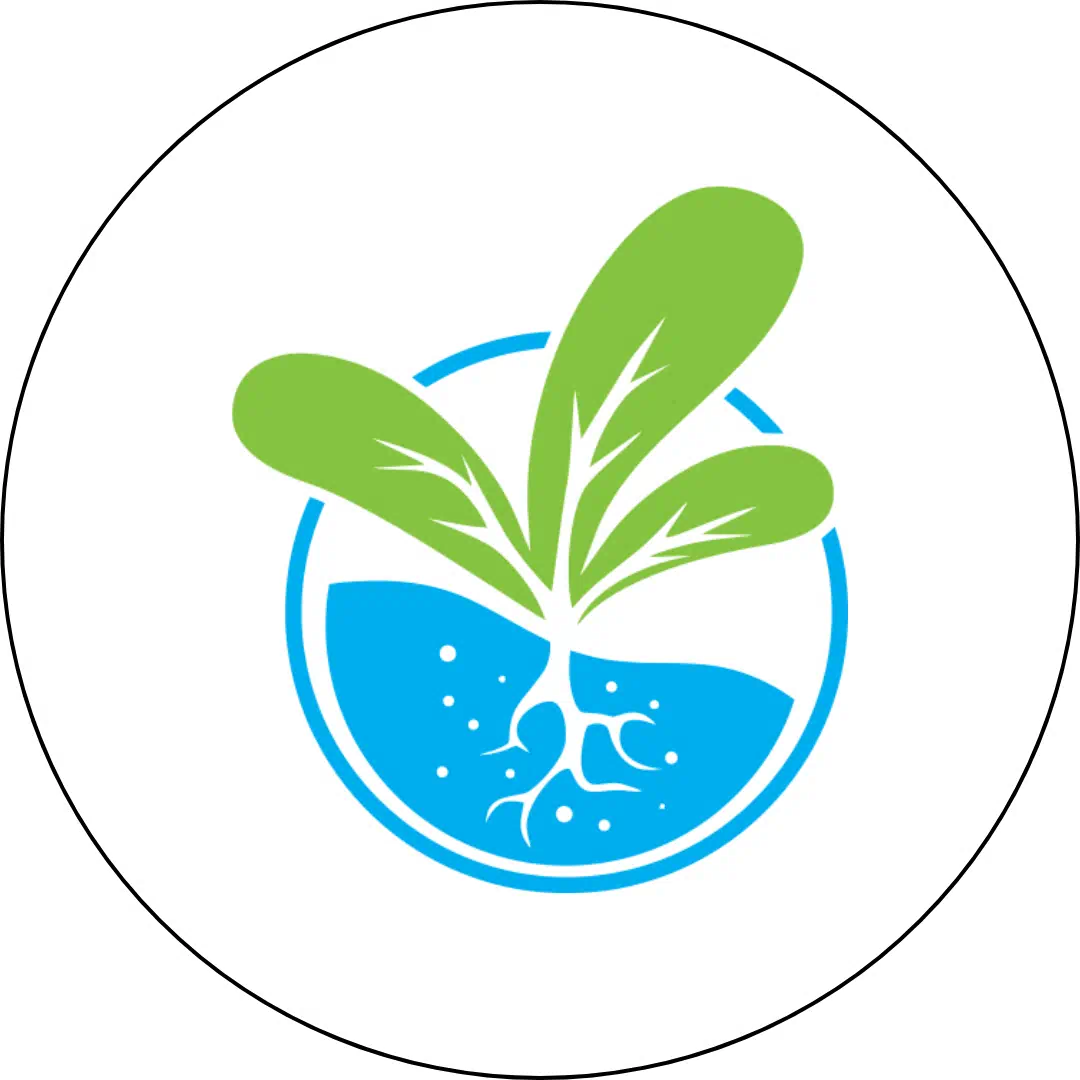
We have scanned over 500+ different types of organisms
You can check out the list by clicking the button.
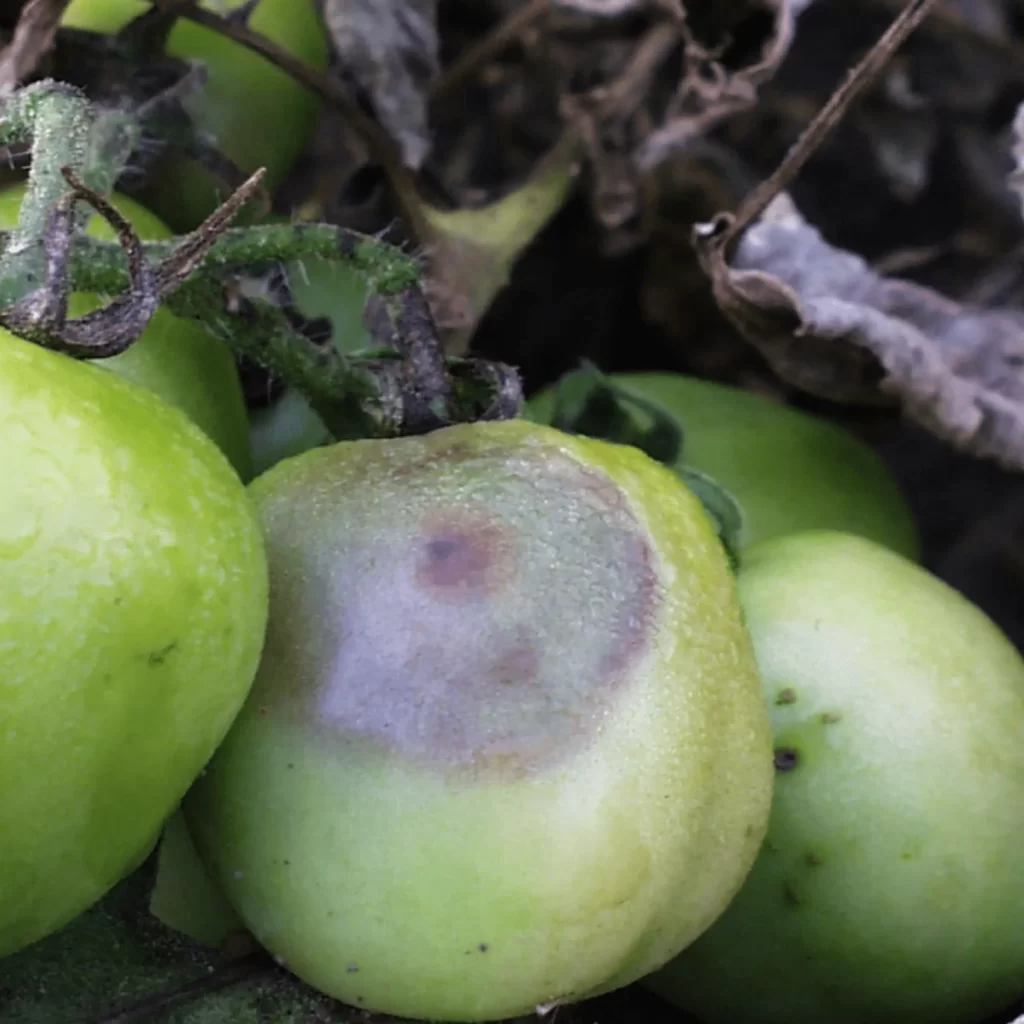
Spring Greenhouse Disease Prevention in Tomatoes: Late Blight Insights
Spring Pathogen Snapshot
Under favorable spring microclimates—pre-dawn mist, daytime highs of 18–22 °C, and RH often above 90 %—Phytophthora infestans (late blight) lesions can form within 10 h of infection, with rapid cell death and sporangia production. Infected plants develop water-soaked lesions on leaves and stems, which expand quickly under persistent humidity, leading to defoliation and fruit rot if unchecked.
Volunteer tomato transplants and cull piles serve as primary inoculum sources, as P. infestans sporangia survive in living tissues or decaying debris, re-establishing disease focus in new spring plantings.
Challenges to Spring Greenhouse Disease Prevention
- Under spring temperatures (15–21 °C) and extended leaf wetness, sporangia can infect within 10 h and produce new inoculum before lesions are spotted .
- Emergence of mandipropamid-resistant EU43 genotypes combined with volunteer tomato plants harboring spores from the previous season sustains disease pressure into spring .
- Thermal inversions and poor ventilation create condensation “hotspots” and dew periods exceeding 10 h under RH > 90 %, ideal for sporangia germination .
Spring Management Protocols
- Climate & Ventilation Controls: Use pre-dawn heating to keep canopy temperatures above 18 °C, target ≥ 5 air exchanges per hour, and maintain RH below 85 % with timed vents or dehumidifiers.
- Irrigation Sanitation & Monitoring: Perform a monthly acid flush (pH 3.5 for 6 h) followed by a 2 ppm free-chlorine rinse in reservoirs; collect runoff and perform a Complete Water and Complete Solution analysis with SGS to verify water quality and nutrient balance.
- Hygiene & Pathogen Surveillance: Rogue volunteer plants and remove cull piles; sanitize benches and tools weekly with > 70 °C water plus surfactant; run HH Pathogen+ on propagation media to catch latent P. infestans inoculum, and send substrate samples for SGS Media Analysis (Basic) to monitor pH, EC, and early substrate-borne risk factors.
Additional Resources
To dive deeper on late blight (Phytophthora infestans) and spring management in greenhouse tomato crops, explore these sources:
- Davis, R. M. (emeritus), Miyao, G. (emeritus), Subbarao, K. V., Stapleton, J. J., & Aegerter, B. J. (2013). Late blight (Phytophthora infestans). UC IPM Pest Management Guidelines for Tomatoes. University of California Statewide IPM Program. Text updated 12/13; treatment table updated 12/13. Acknowledgements: B. W. Falk; R. L. Gilbertson. Retrieved from https://ipm.ucanr.edu/agriculture/tomato/late-blight/
- Sudermann, M. (2025). Late blight. Cornell Vegetable Program, College of Agriculture and Life Sciences, Cornell University. Retrieved from https://www.vegetables.cornell.edu/crops/tomatoes/late-blight/
- Dicklow, M. B., & Madeiras, A. (2019, October 1). Garden Retailers and Late Blight Disease. UMass Extension Greenhouse Crops & Floriculture Program, University of Massachusetts Amherst. Retrieved from https://ag.umass.edu/greenhouse-floriculture/fact-sheets/garden-retailers-late-blight-disease
- Quesada-Ocampo, L., & Meadows, I. (2023, January 9). Tomato Late Blight. N.C. Cooperative Extension. Retrieved from https://content.ces.ncsu.edu/tomato-late-blight
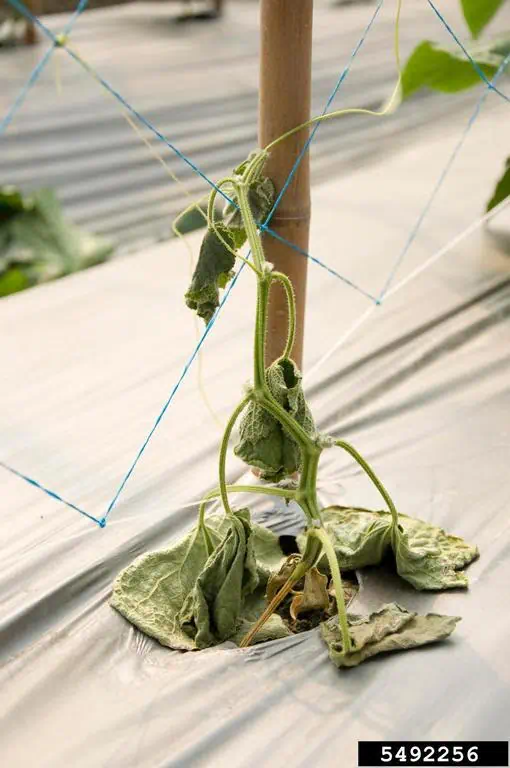
Spring Greenhouse Disease Prevention in Cucumbers: Pythium Root Rot Monitoring
Spring Pathogen Snapshot
Pythium aphanidermatum can spike in spring recirculating systems as solution temperatures warm to 20–25 °C, fueled by algal blooms at pH > 6.2 and protective biofilms in drip lines. Zoospores produced within those biofilms swim through water films, infecting root collars and causing root browning and wilting within 10–14 days if left unchecked. Continuous circulation of contaminated nutrient solution amplifies inoculum loads and disperses pathogens throughout the crop.
Challenges to Spring Greenhouse Disease Prevention
- Elevated pH (> 6.2) promotes algal growth, which depletes dissolved oxygen and shelters zoospores in low-flow microzones.
- Microbial films in emitters protect Pythium from disinfectants, allowing rapid recolonization even after sanitation.
- Spring temperatures accelerate oomycete growth, leading to 20–40 % yield losses before visible symptoms prompt intervention.
Spring Management Protocols
- pH Control & Algae Suppression: Maintain nutrient solution pH at 5.5–6.0 with phosphoric acid to limit algal blooms; consider periodic slightly acidic electrolyzed water (SAEW) treatments to inhibit both algae and oospore viability .
- Biofilm Disruption & Filtration: Flush lines weekly with hot water (> 50 °C) and nonionic surfactant, or install sand/membrane filters upstream of emitters to remove biofilms and reduce Pythium CFUs by > 70 % .
- Diagnostic Monitoring: Collect solution and root-zone samples biweekly; run HH Pathogen Mini qPCR assays for targeted Pythium aphanidermatum detection (sensitivity down to 8 copies/µL) and submit monthly samples to SGS Complete Water analysis for pH, EC, and microbial load confirmation .
Additional Resources
To explore the spring dynamics of Pythium root rot and advanced control strategies in recirculating hydroponic cucumber systems, see these resources:
- Goldberg, N. P., Stanghellini, M. E., & Rasmussen, S. L. (1992). Filtration as a method for controlling Pythium root rot of hydroponically grown cucumbers. Plant Disease, 76(8), 777–779. ual.es
- Zheng, J., Sutton, J. C., & Yu, H. (2000). Interactions among Pythium aphanidermatum, roots, root mucilage, and microbial agents in hydroponic cucumbers. Canadian Journal of Plant Pathology, 22(4), 368–379. https://doi.org/10.1080/07060660009500455
- Penn State Extension. (n.d.). Pythium. Penn State Extension. Retrieved from https://extension.psu.edu/pythium
- Hochmuth, R. C. (2011). Greenhouse Cucumber Production—Florida (Greenhouse Vegetable Production Handbook, Vol. 3, Publication CV268). University of Florida IFAS Extension. Retrieved from https://edis.ifas.ufl.edu/publication/CV268
- Beckerman, J. (2011). Pythium Root Rot of Herbaceous Plants (BP-181-W). Purdue Extension, Purdue University Department of Botany and Plant Pathology. Retrieved from https://www.extension.purdue.edu/extmedia/bp/bp-181-w.pdf
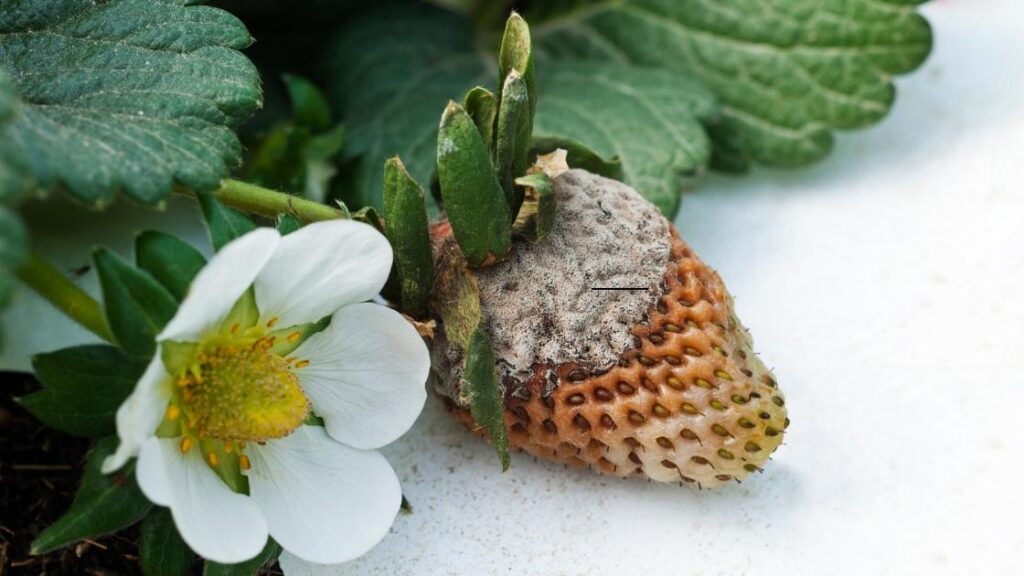
Spring Greenhouse Disease Prevention in Strawberries: Gray Mold & Neo-P
Spring Pathogen Snapshot
In spring, indoor strawberry production shifts into peak flowering and fruiting under controlled climates (day: 16–20 °C; night: 7–12 °C). However, these conditions—especially high humidity (> 85 % RH) and extended leaf wetness—favor two key pathogens: Botrytis cinerea (gray mold) and Neopestalotiopsis spp. (“Neo-P”). Gray mold infects senescing blossoms and fruit via airborne conidia that germinate under moisture films, while Neo-P causes leaf spot, fruit rot, and crown infections, often introduced on planting stock. Integrated management—rigorous environmental control, sanitation, and proactive diagnostics—is critical to prevent spring epidemics.
Challenges to Spring Greenhouse Disease Prevention
- Concurrent gray mold and Neo-P outbreaks: Both Botrytis cinerea and Neopestalotiopsis thrive under the same high-humidity (> 85 % RH) and extended leaf-wetness (> 10 h) conditions, leading to simultaneous flower and fruit infections and compounding yield losses.
- Rapid splash and contact spread: Overhead irrigation droplets, worker movement, and contaminated tools move inoculum swiftly through dense canopies, outpacing standard sanitation routines.
- Latent infection phases: Gray mold can infect in as little as 6 h of dew, and Neo-P colonizes tissue with minimal early symptoms, making timely visual detection and intervention challenging.
Spring Management Protocols
- Climate & Airflow: Reduce leaf wetness by targeting RH < 80 % with dehumidification and horizontal airflow across the canopy.
- Sanitation: Remove and destroy infected blossoms, fruit, and leaf debris daily; disinfect tools and benches with hot water (> 70 °C) plus surfactant.
- Planting Material: Source certified, disease-free transplants; quarantine new stock and test symptomatic plants using HH Pathogen Mini assays for B. cinerea or Neo-P to confirm pathogen identity.
Additional Resources
To further explore spring disease risks and integrated control strategies for Botrytis cinerea (gray mold) and Neopestalotiopsis spp. (Neo-P) in greenhouse-grown strawberries, see these recommended readings:
- University of California Statewide IPM Program. (n.d.). Botrytis fruit rot of strawberry. UC IPM Pest Management Guidelines for Strawberry. Retrieved from https://ipm.ucanr.edu/agriculture/strawberry/botrytis-fruit-rot/
- Grout, M., Mattson, N., & Daughtrey, M. (2019). Gray mold of greenhouse strawberries (E402). e-GRO Rapid Problem Diagnosis. Retrieved from https://e-gro.org/pdf/E402.pdf
- Cline, B., Moparthi, S., & Hoffmann, M. (2024). Neopestalotiopsis leaf, fruit, and crown rot of strawberry. North Carolina Cooperative Extension, Entomology & Plant Pathology. Retrieved from https://content.ces.ncsu.edu/neopestalotiopsis-leaf-fruit-and-crown-rot-of-strawberry
- Baggio, J. S., & Peres, N. A. (2021). Neopestalotiopsis disease in strawberry: What do we know? UF/IFAS Gulf Coast Research and Education Center. Retrieved from https://smallfruits.org/2021/10/neopestalotiopsis-disease-in-strawberry-what-do-we-know/
- Goldenhar, K., & Pate, E. (2021). Pest alert: Neopestalotiopsis – An emerging strawberry disease in North America. Ontario Ministry of Agriculture, Food and Rural Affairs (OMAFRA). Retrieved from https://onfruit.ca/wp-content/uploads/2021/03/Pest-Alert-Neopestalotiopsis-.pdf
- Guan, W., Bonkowski, J., Creswell, T., & Egel, D. S. (2023, April 17). Strawberry cultivar susceptibility to Neopestalotiopsis leaf spot. Plant Health Progress. https://doi.org/10.1094/PHP-05-22-0049-RS
- Ávila-Hernández, J. G., León-Ramírez, C. G., Abraham-Juárez, M. del R., Tlapal-Bolaños, B., Olalde-Portugal, V., Délano-Frier, J. P., Martínez-Antonio, A., & Aguilar-Zárate, P. (2025). Neopestalotiopsis spp.: A threat to strawberry production and management. Horticulturae, 11(3), 288. https://doi.org/10.3390/horticulturae11030288
- Brannen, P. (2024, August 21). Dramatic Neopestalotiopsis disease in strawberry tips and plug plant production nurseries. University of Georgia Extension. Retrieved from https://site.extension.uga.edu/strawberry/2024/08/dramatic-neopestalotiopsis-disease-in-strawberry-tips-and-plug-plant-production-nurseries/
- Hoffmann, M. (2020). A new disease is emerging: Neopestalotiopsis fruit rot. North Carolina State University Strawberry Program. Updated by Hopper, B. (2024, October 22). Retrieved from https://strawberries.ces.ncsu.edu/2020/09/a-new-disease-is-emerging-neopestalotiopsis-fruit-rot/
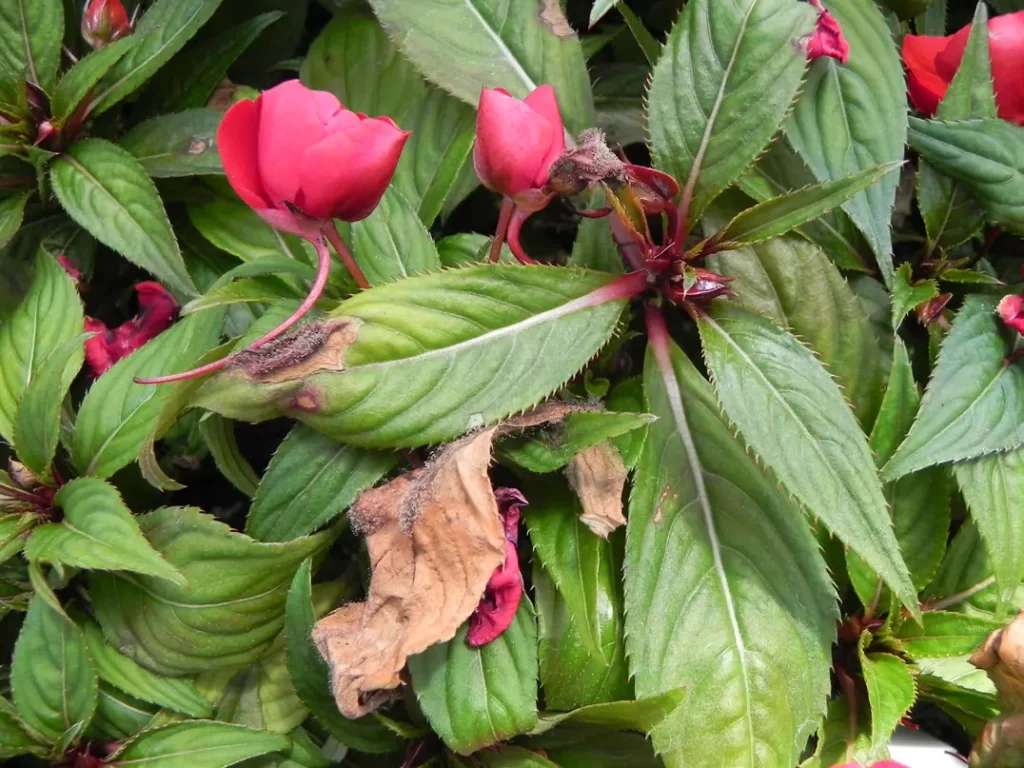
Spring Greenhouse Disease Prevention in Ornamentals: Gray Mold & Bacterial Speck
Spring Pathogen Snapshot
In spring, greenhouse ornamentals often experience days of 18–25 °C coupled with high canopy humidity (> 85 % RH), creating ideal conditions for Botrytis cinerea (gray mold) and Pseudomonas spp. to infect – Botrytis conidia germinate on water-soaked petals and leaves after 8–12 h of continuous moisture at 13–18 °C, producing fuzzy gray sporulation that spreads rapidly in humid air currents. Initial infections appear as water-soaked brown spots on blossoms and foliage, then develop into widespread blight under dew-laden conditions.
Meanwhile, Pseudomonas syringae and related pathovars cause expanding leaf spots and blossom blights with yellow halos when RH exceeds 90 % and leaf wetness persists, often entering through wounds or natural openings
Challenges to Spring Greenhouse Disease Prevention
- Dual pathogen pressure: Gray mold and bacterial spots exploit the same humid microclimates, complicating timing and choice of control measures.
- Moisture “hotspots”: Poor air circulation in dense benches leads to condensation pockets that fuel both Botrytis sporulation and Pseudomonas spread.
- Latent infections: Botrytis can establish under minimal symptoms within 6 h of dew, and Pseudomonas lesions often mimic water stress or nutrient disorders, delaying detection.
Spring Management Protocols
- Environmental Controls: Maintain RH ≤ 80 % with horizontal airflow fans and timed ventilation; avoid overhead misting and use dehumidifiers during morning condensation peaks.
- Sanitation & Cultural: Remove and destroy senescent blossoms, leaves, and debris daily; sanitize benches, tools, and irrigation nozzles with > 70 °C water plus nonionic surfactant; space plants to improve air movement.
- Monitoring & Diagnostics: Track leaf wetness and relative humidity (RH) with sensors. When high-risk periods occur, collect symptomatic tissue and run a Pathogen Mini test to confirm the presence of Botrytis or Pseudomonas, guiding targeted interventions.
Additional Resources
To deepen your understanding of springtime gray mold and bacterial blight dynamics in controlled-environment ornamentals, these resources provide actionable insights:
- Ford, T. (2023). Managing Botrytis or gray mold in the greenhouse. Penn State Extension. Retrieved from https://extension.psu.edu/managing-botrytis-or-gray-mold-in-the-greenhouse
- Hausbeck, M., & Harlan, B. (2023). Botrytis control tips for greenhouse ornamentals. Michigan State University Extension, Department of Plant, Soil and Microbial Sciences. Retrieved from https://www.canr.msu.edu/news/botrytis-control-tips-for-greenhouse-ornamentals
- Wick, R. L., & Madeiras, A. (2019). Botrytis blight of greenhouse crops. UMass Extension Greenhouse Crops & Floriculture Program. Retrieved from https://ag.umass.edu/greenhouse-floriculture/fact-sheets/botrytis-blight-of-greenhouse-crops
- UMass Extension Greenhouse Crops & Floriculture Program. (2025). Geranium – Bacterial leaf spot (Pseudomonas syringae). University of Massachusetts Amherst Extension. Retrieved from https://ag.umass.edu/greenhouse-floriculture/photos/geranium-bacterial-leaf-spot-pseudomonas-syringae
- Washington State University Extension. (2022). Ornamental pear: Pseudomonas blossom blast and dieback. WSU Extension Hortsense. Retrieved from https://hortsense.cahnrs.wsu.edu/fact-sheet/ornamental-pear-pseudomonas-blossom-blast-and-dieback/
- USU Extension. (2025). Brown bacterial spot of herbaceous ornamentals. Utah State University Extension, Plant Health IPM Program. Retrieved from https://extension.usu.edu/planthealth/ipm/notes_ag/veg-bacterial-brown-spot
- Kansas State University. (2023). Pseudomonas Blight of Trees and Shrubs – Pseudomonas syringae. Kansas State University Agricultural Experiment Station and Cooperative Extension Service. Retrieved from https://hnr.k-state.edu/extension/info-center/common-pest-problems/common-pest-problem-new/Pseudomonas%20Blight%20of%20Trees%20and%20Shrubs.pdf
Spring IPM and Summer Prep for Greenhouses: Integrating qPCR Testing & Analytical Services
As you transition from crop-specific spring management into a preventative summer regime, layer these HH and SGS assays and analyses into your IPM calendar to stay one step ahead of pathogens and nutrient drift.
For more on SGS and HH services in one place, visit this page.
Baseline Testing (Pre-Planting & Early Spring)
- HH Pathogen+ Full Scan: DNA sequencing scan of media, water or swabs to flag any lurking fungi, oomycetes or bacteria before transplant.
- SGS Media Analysis (Complete): Confirm mix pH, EC, macronutrients (N, P, K, Ca, Mg, S), micronutrients (Fe, Zn, Mn, Cu, B, Mo) and, for soilless blends, physical properties (porosity, water-holding capacity).
- SGS Complete Water Analysis: Verify irrigation-water quality and nutrient balance (pH, EC, nitrate-N, P, K, Ca, Na, Cl⁻, SO₄, micronutrients, hardness, TDS).
Routine Monitoring (Late Spring → Early Summer)
- HH Pathogen Mini (every 7–14 days)
- Peppers: qPCR on leaf wash or drench water for Leveillula taurica and Fusarium oxysporum
- Tomatoes: qPCR on media/substrate for Phytophthora infestans
- Cucumbers: qPCR on solution or root-zone wash for Pythium aphanidermatum
- Strawberries & Ornamentals: qPCR on blossoms, fruit or leaf for Botrytis cinerea and Neopestalotiopsis spp.
- SGS Complete Solution Analysis: Weekly verification of your fertigated mix (pH, EC, N–NO₃, P, K, Ca, B) so nutrient ratios stay on target as temperatures climb.
- SGS Complete Water Analysis (monthly): Re-test source water and reservoir TDS to catch salt build-up under high evaporation.
Diagnostic Scans (As-Needed, Any Season)
- HH Pathogen+ Fungal Scan: A scan with 500+ fungal targets can unmask mixed infections or emerging strains when you see unexplained wilting or spotting.
- SGS Plant Tissue Analysis: Basic (N, P, K, Mg, Ca) or Complete (N, P, K, Mg, Ca, S, Zn, Cu, Fe, B) to rule out nutrient disorders that mimic disease
Summer Prep & Data-Driven Adjustments
- Environmental Controls: Use test data to fine-tune ventilation, fogging and dehumidification so RH stays below crop-specific thresholds (peppers ≤ 75 %, tomatoes ≤ 85 %, ornamentals/strawberries ≤ 80 %).
- Sanitation & Biocontrol Timing: Increase bench and tool sanitation or introduce microbial antagonists (e.g., Bacillus spp.) immediately after detecting pathogen upticks.
- Cultivar & Rotation Planning: If HH Pathogen+ reveals persistent inoculum, pivot to heat-tolerant or disease-resistant pepper and tomato lines for mid-summer cycles.
- Media & Irrigation Strategy: Leverage SGS Media and Water analyses to adjust substrate blends for better moisture retention and recalibrate nutrient strength as plant uptake accelerates.
By pairing HH’s rapid qPCR and comprehensive sequencing scans with SGS’s deep-dive water, media, and tissue analytics, you’ll transition seamlessly from spring propagation into a robust, data-driven summer program—maximizing yield, minimizing chemical inputs, and keeping disease at bay.
Disclaimer
The information presented in this blog is based on collating published peer-reviewed scientific literature and sources that we consider reliable. This is by no means an exhaustive review of pathogens and IPM strategies. This blog provides a brief overview of what is known about pathogens. We encourage growers to do more research on the pathogens concerning their crops and hydroponic systems. We are not plant pathologists; therefore, the information presented should not be used as professional advice for treating pathogens or operating your system.


